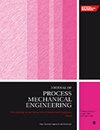Exploring the cutting edge: Recent trends in cold metal transfer welding
IF 2.2
4区 工程技术
Q2 ENGINEERING, MECHANICAL
Proceedings of the Institution of Mechanical Engineers, Part E: Journal of Process Mechanical Engineering
Pub Date : 2024-09-10
DOI:10.1177/09544089241276708
引用次数: 0
Abstract
Cold metal transfer welding is known for its automated welding process, which is equipped with shortcircuit-based deposition of filler wire, which allows it to control its heat input parameter properly along with a wire feed rate. Cold metal transfer’s main characteristic, which greatly affected the manufacturing industries, is joining thin, similar, or dissimilar metal sheets as the processing heat input is minimal. This review paper (covering 104 studies) examines how joining different metals with varying welding parameters affects their weld appearance, microstructure, tensile strength, and the formation of joint failure. The main focus was on what additional methods, like hardfacing or post-heat treatment of material, must be adopted to enhance the joint's weld quality and appearance. The paper starts with the investigation of numerous dissimilar weld joints formed by the cold metal transfer technique, along with the effect of varying welding parameters and ultrasonic-assisted cold metal transfer hybrid welding on the weld quality and post–pre-weld heat treatment of materials. A comparison of different cold metal transfer arc modes employed in wire-arc additive manufacturing has also been discussed briefly. At the end of the analysis, it was noted that some metal joints had a positive impact, and some gained a negative effect while increasing the heat input. The research articles studied in this paper indicate that not every material would exhibit the same welding property when subjected to a specific set of varying welding parameters.探索前沿:冷金属转移焊接的最新趋势
冷金属转移焊接因其自动化焊接工艺而闻名,该工艺配备了基于短路的填充焊丝熔敷技术,可适当控制热输入参数和焊丝进给速度。冷金属转移的主要特点是连接薄、相似或不相似的金属板,因为加工过程中输入的热量极低,这对制造业产生了极大的影响。这篇综述论文(涵盖 104 项研究)探讨了不同金属在不同焊接参数下的连接如何影响其焊缝外观、微观结构、抗拉强度以及连接失效的形成。主要重点是必须采取哪些额外的方法,如硬面堆焊或材料的后热处理,以提高接头的焊接质量和外观。论文首先调查了通过冷金属转移技术形成的大量异种焊接接头,同时还调查了不同焊接参数和超声波辅助冷金属转移混合焊接对焊接质量和材料焊后预热处理的影响。此外,还简要讨论了线弧增材制造中采用的不同冷金属转移电弧模式的比较。分析结果表明,在增加热输入的同时,一些金属接头产生了积极影响,而一些金属接头则产生了消极影响。本文研究的文章表明,并非每种材料在一组特定的不同焊接参数下都会表现出相同的焊接特性。
本文章由计算机程序翻译,如有差异,请以英文原文为准。
求助全文
约1分钟内获得全文
求助全文
来源期刊
CiteScore
3.80
自引率
16.70%
发文量
370
审稿时长
6 months
期刊介绍:
The Journal of Process Mechanical Engineering publishes high-quality, peer-reviewed papers covering a broad area of mechanical engineering activities associated with the design and operation of process equipment.

 求助内容:
求助内容: 应助结果提醒方式:
应助结果提醒方式:


